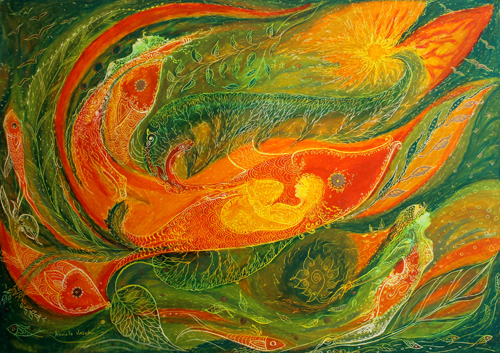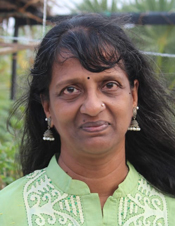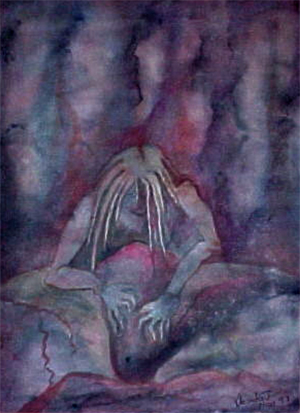A canvas of resistance and expressions of collective voice

Women in nature
When Kamala Vasuki was an A’ L student, she walked into Chundikuli Girls’ College in Jaffna and saw an art exhibition by three women who were students of two art masters. She had never seen an art exhibition before and the effect was transformative. While she had learned art as a subject in school, her imagination was confined to art as something that existed as paintings in temples or in magazines from Tamil Nadu. It was only then that she realized that being an artist was an option, that art could spill over into multiple genres and expressions outside of what she had perceived it to be.
“We never had a dream at that time that you can become an artist like that. That never sounded like something that you can choose,” says Vasuki matter of factly.
That day, she went home and lamented to her family about the lack of support she had received to pursue her interest in art. The next day, her father and uncle cycled out and found A. Mark, one of the art masters these students had learned under, and Vasuki was promptly enrolled in his art classes. She pursued an undergraduate degree in bioscience but her evenings were spent at art classes. Despite the upheaval with the war, multiple interruptions with university, the IPKF interventions, bombings, displacement and loss, Vasuki continued with her art and to date, this is a strand which is tightly woven into her life and work.

Kamala Vasuki
“I decided that this is going to be one part of my life because I was so comfortable in expressing myself,” she says, while in Colombo a few weeks ago in preparation for her upcoming exhibition in Batticaloa, where she now lives.
For this feminist activist and artist, art has been a medium to resist and bear witness. She found herself resisting traditional, gendered roles that women were slotted into, especially in Jaffna, and art became a terrain for her to visually explore this refusal to accept gendered societal norms.
Although most of her original work was lost after the 1995 exodus from Jaffna,Vasuki’s art evocatively bears witness to events in the North and East. Footprints of death (1987/1988) captures a moment witnessed on the way from Vadukottai to Jaffna after the Indian Peace Keeping Force captured Jaffna – after living in a bunker for eight days and witnessing countless deaths and shellings, she was walking in a women’s line and passed a pile of assorted skulls of cows, dogs and human beings on the ground, close to a popular cremating area in Jaffna. Seared in her mind, that image found its way into a painting a year later.

In search of the buried
In pieces like “Krishanthi”, a shift in mediums and styles can also be seen. The mixed media painting responds to the gang rape and murder of schoolgirl Krishanthi Kumaraswamy by six soldiers. Her mother, younger brother and a neighbour who went in search of her were also killed and buried. In “Krishanthi”, Vasuki deployed an almost Sisyphean creative technique where she would sellotape the paper onto a board, paint in dark watercolours and then hold the paper under the kitchen tap until a pale shadow of the painting remained. She would then repeat the process multiple times until the painting was complete. A close examination of the painting which shows murky figures hovering over a girl’s figure lying on the ground reveals the paper hillocks where the damp paper has dried and curled.
Material also determined style. “We didn’t have any art material, so we drew on typing sheets using ballpoint pens or schoolchildren’s pastels. We took our teacher’s 20-year-old colours and we crushed it and tried to mix it with things. We also used printing ink at that time – it was like a sticky, chewing gum thing and we mixed it with kerosene and used it. So, these also determined the colour and expressions,” she explains.
When she moved to Batticaloa 27 years ago and began to work on women’s issues, she began to gravitate towards themes of nature and women – both markedly visible in her upcoming exhibition. Fish, women, birds, lush foliage, waves, water abound in multiple artworks bursting with colour – artistic resistance towards witnessing people move away from nature.
Community art and community-led creative practices also have played a part in Vasuki’s art. Creative practices take root in her daily work as an activist and she considers herself a community-based artist.
“Art is an easy way for me to bring the ideas of others and I also found that women are very comfortable in expressing themselves through colours and pieces of cloth, lines and this and that. So that is how we started doing collective art. I found that my imagination, my conceptualization and creativity could bring different voices together into one piece, rather than only myself expressing something,” she says.
In recent times, the people’s protests have occupied her imagination and she uses cartoons to directly engage with people online and as a form of societal critique. These will also be on display at her exhibition.
‘Kamala Vasuki – A Retrospective (1989 – 2023)’ will held from April 5 – 10 at 55, Lady Manning Drive, Batticaloa from 9 a.m. – 5 p.m.
Searching for an ideal partner? Find your soul mate on Hitad.lk, Sri Lanka's favourite marriage proposals page. With Hitad.lk matrimonial advertisements you have access to thousands of ads from potential suitors who are looking for someone just like you.


